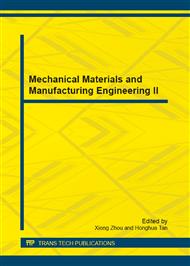[1]
Y. Zhang, J. Alexander, Sensitivity of liquid bridges subject to axial residual acceleration, J. Physics of Fluids A: Fluid Dynamics. 2 (1990) 1966-(1974).
DOI: 10.1063/1.857672
Google Scholar
[2]
J. A. Nicolas, J. M. Vega, Weakly nonlinear oscillations of nearly inviscid axisymmetric liquid bridges, J. Fluid. Mech. 328 (1996) 95-128.
DOI: 10.1017/s002211209600866x
Google Scholar
[3]
C. P. Lee, A. V. Anilkumar, T. G. Wang, Streaming generated in a liquid bridge due to nonlinear oscillations driven by the vibration of an endwall, J. Physics of Fluids A: Fluid Dynamics. 8 (1996) 3234-3246.
DOI: 10.1063/1.869114
Google Scholar
[4]
D. V. Lyubimov, T. P. Lyubimova, R. V. Skuridin, G. Chen, B. Roux, Numerical investigation of meniscus deformation and flow in an isothermal liquid bridge subject to high-frequency vibrations under zero gravity conditions, J. Comput. Fluids. 31 (2002).
DOI: 10.1016/s0045-7930(01)00078-0
Google Scholar
[5]
Y. Kanashima, K. Nishino, S. Yoda, Numerical investigation of meniscus deformation and flow in an isothermal liquid bridge subject to high-frequency vibrations under zero gravity conditions, J. Microgravity Sci. Technol. 16 (2005) 285-289.
DOI: 10.1016/s0045-7930(01)00078-0
Google Scholar
[6]
R. Q. Liang, M. Kawaji, Numerical investigation of meniscus deformation and flow in an isothermal liquid bridge subject to high-frequency vibrations under zero gravity conditions, J. Microgravity Sci. Technol. 21 (2009) 31-37.
DOI: 10.1016/s0045-7930(01)00078-0
Google Scholar
[7]
S. Osher and J. Sethian, Fronts propagating with curvature dependent speed: algorithms based on hamilton-jacobi formulations, J. Computational. Phys. 79 (1988) 54-63.
DOI: 10.1016/0021-9991(88)90002-2
Google Scholar
[8]
M. Sussman, P. Smereka, S. Osher, A level set approach for computing solutions to incompressible two-phase flow , J. Computational. Phys. 114 (1994) 146-159.
DOI: 10.1006/jcph.1994.1155
Google Scholar
[9]
R.Q. Liang, Z.Q. Liao, W. Jiang, G.D. Duan, J.Y. Shi, P. Liu, Numerical simulation of water droplets falling near a wall: existence of wall repulsion, J. Microgravity Sci. Technol. 23 (2011a) 59-65.
DOI: 10.1007/s12217-010-9230-9
Google Scholar
[10]
R.Q. Liang Z.Q. Liao, S. Liang, Solving dam break problem considering wall adhesion, J. Microgravity Sci. Technol. 23 (2011b) 49-57.
DOI: 10.1007/s12217-010-9229-2
Google Scholar


